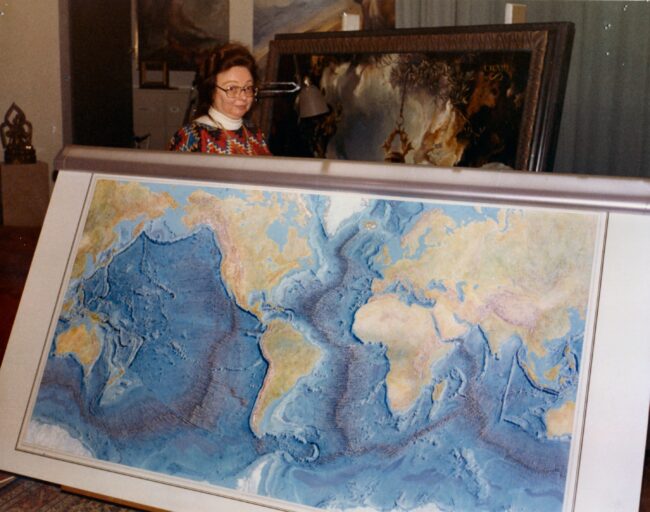
Today marks what would have been Marie Tharp’s 105th birthday. The pioneering geologist and cartographer’s legacy continues to resonate across the ocean sciences, 19 years after her death and nearly a half-century after she composed, along with her colleague Bruce Heezen, the first complete map of the depths of the ocean—without ever having set foot on a ship. (At the time, women scientists were prohibited from traveling on research vessels.) This map, which she published in 1977, helped to support the theory of plate tectonics or continental drift—a radical notion at a time.
Tharp began working at the Lamont Geological Laboratory (now the Lamont-Doherty Earth Observatory) in 1948—a time when research produced by women scientists was often discredited. Today, the geosciences community recognizes Tharp as a revolutionary cartographer and geologist whose work continues to inspire and inform legions of ocean scientists.
In honor of her birthday, State of the Planet pays tribute to Tharp and those who have carried her vision forward. Learn more about Tharp and about current ocean research by visiting our Marie Tharp website and checking out the stories below.
Leveraging the Power of Open Source Data To Map the World’s Oceans: To celebrate World Oceans Day, marine geophysicist Vicki Ferrini discusses the current state of ocean research, and the important role international collaboration plays in this field. Ferrini also heads the Atlantic and Indian Ocean Center of the Nippon Foundation-GEBCO Seabed 2030 Project (Seabed 2030), which is a global initiative that seeks to complete the map of the ocean floor and provide a publicly accessible seabed map by 2030.
Marie Tharp’s Adventures in Mapping the Seafloor, In Her Own Words: The pioneering mapmaker explains how she and colleagues discovered underwater mountain ranges 40,000 miles long and helped to prove that the continents move.
Lamont’s Marie Tharp: She Drew the Maps That Shook the World: On the 100th anniversary of her birth, Tharp’s grit and brilliance are as legendary as her work.
How Much Carbon Can the Ocean Hold? Lamont Researchers Aim To Find Out: Galen McKinley and her research group are quantifying how much carbon the ocean removes from the atmosphere—and how much it fluctuates—to better understand climate change.
The R/V Marcus G. Langseth Helps Map the World’s Oceans: For the first time in almost nine years, Lamont-Doherty Earth Observatory’s R/V Marcus G. Langseth returned to New York City for some much-needed TLC. State of the Planet got a tour of this impressive seismic vessel, learning how it can help researchers forecast earthquakes and save lives in the process.
Seismic Imaging Aboard the R/V Marcus G. Langseth: See how the R/V Marcus G. Langseth uses seismic imaging to make detailed maps of the seafloor.
8 Surprising Facts About Marie Tharp, Mapmaker Extraordinaire: Maybe you already know that she created some of the first maps of the ocean floor and helped discover plate tectonics. Here are some lesser-known facts about this history-making cartographer.
Pod of the Planet Ep. 8: Marie Tharp’s Girl Talk: Pod of the Planet celebrates the life of Marie Tharp and the inspiration she has been and continues to be to many today.
Google Doodle Celebrates Marie Tharp, Who Mapped the Ocean Floor: On November 21, 2022, an interactive Google Doodle highlighted Tharp’s pioneering work.


